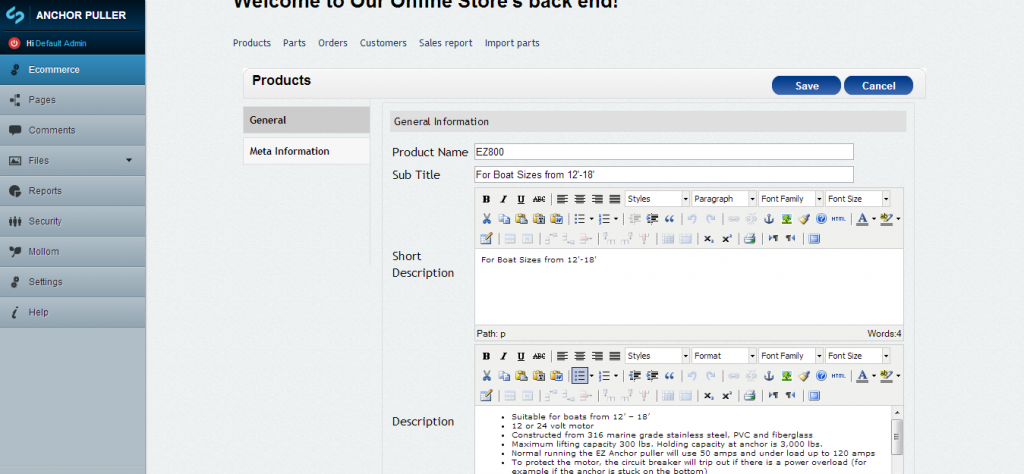This blog post is one part in a series. Click to see the other posts related to the benefits of a content management solution.
Many websites go beyond just being informative: they sell products too. While having an e-commerce website can provide extra revenue streams for a business, a more important feature is to ensure any e-commerce website design is based around a sound strategy for growth that accommodates modern content marketing needs. Most e-commerce solutions by themselves don’t achieve this as their built in content creation is typically limited to product information and basic web pages. In fact, most businesses typically build the content marketing portion of a web site on a content management solution with products build on a separate e-commerce platform, requiring employees to switch between the two continuously when making product updates, reviewing product descriptions across pages, or multi-tasking in disparate functions such as order fulfillment and FAQ maintenance.
This blog post explores the feasibility of combine software focused on e-commerce with software that specializes in content management seamlessly, into one solution, that streamlines management and makes everyone’s job easier.
E-Commerce Content Management Integration Solutions

Example product management screens available within a SilverStripe content management backend for seamless editing of products and content.
Integrating an e-commerce website with a content management solution gives an administrator the flexibility and ease of mind of controlling a wide variety of information whether related to products or not, all from a single back-end interface with a single login. At any time, an administrator can login to the same back end administrative web site to add more products, write blog posts, create case studies, remove products, update pricing, approve orders, and generally conduct all critical tasks related to e-commerce management and content marketing.
Depending on how the website is designed and developed, there could also be no limitations on the segmentation of products either. Products may be categorized in one, or many, subcategories, allowing them to be accessed through many different pages on the front end of the website.
Last but not least, editing product information in the e-commerce “portion” of the solution causes the same information to show up in the “content management” portion, and vice versa. Being able to monitor payments and sales along side blog posts or social media feeds is liberating, especially for top level managers that should have access to all admin areas, or to mid sized companies where e-commerce employees often handle multiple functions. The added ease provides important customer service benefits – ensuring that product content added to products is also available in any related pages managed by the content management solution reduces errors, which can save costly problems where consumers rely on information being up to date.
On top of the ease of use in maintaining e-commerce products with a content management solution, there are many added modules from e-commerce to content management that can be combined into a single solution to further set your e-commerce website apart from other competitors:
- Personalization so customers can log in to view past orders, submit secure messages to customer services and re-order (E-commerce)
- Custom form builder (Content management)
- Sales reports that can be customized by header, report data, date range and other variables (E-commerce)
- Polls and surveys (Content management)
- Discount and Coupon Module (E-commerce)
- Class or event scheduling and sign-up (Content Management)
- Product Configurators that enable personalization of products by customers (E-commerce)
- Blogs (Content Management)
- Incentive Pop Ups (E-commerce)
- Social Media Feeds and Other Integration (Content Management)
- Social Integration after purchase (E-commerce)
- Frequently Asked Questions (Content Management)
- Recommended Products (E-commerce)
- User Comments (Content Management)
- User Reviews (E-commerce)
Maintaining e-commerce products through a content management solution brings many benefits – being able to manage sales and content within the same interfaces saves administrators and marketers a lot of time. Of course, an e-commerce and content management solution integration brings with it some requirements to ensure success:
- Secure login and authentication between both systems
- Seamless integration, ideally at the database level
- A solid role / group based permission system to ensure that employees only access those parts of the web site they have access too – marketing managers to blogs, for example, and customer service to orders fit
- Support of both systems at the template level – i.e., the pages primarily authored by content management should be able to accommodate e-commerce widgets such as “featured products” or “recommended products”
If your business is in need of a scalable e-commerce websites that combines best of breed content management, or if your e-commerce sales just aren’t bringing the ROI you are expecting, contact Polar Design, a trusted and proven e-commerce website development agency to help boost your e-commerce gains and minimize content management pains.
Next up in this content management solution blog series we’ll cover more specific modules that many clients find valuable not only to a website’s functionality, but more importantly to a website administrator’s ease of use. Next up for discussion: video integration.





Pingback: Polar Design Content Management Solutions: Making Website Maintenance Life Easier
Pingback: Polar Design Content Management Solution: Part 3 - Event Calendars